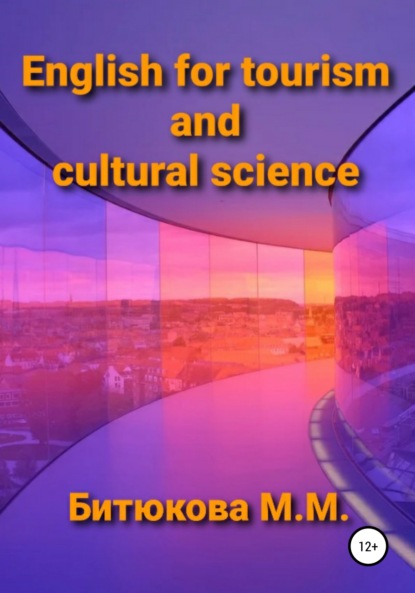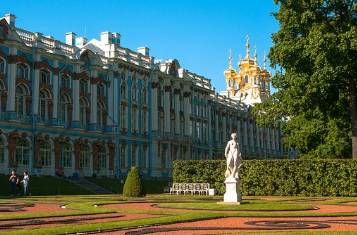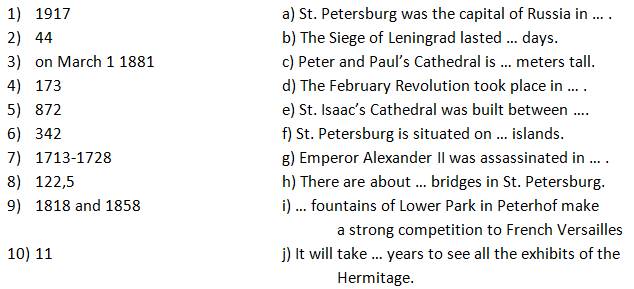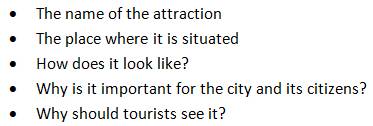
Полная версия:
English for tourism and cultural science
Another of Tsarskoye Selo’s major attractions is the Lyceum, located on the edge of the estate. Founded at the beginning of the 19th century and remarkably well-preserved, the Lyceum was a boarding school that once taught the most celebrated of all Russian poets, Alexander Pushkin. The Lyceum was created specifically to educate members of the Russian ruling elite and prepare them for careers in government service. Visitors to the Lyceum are allowed access to its well-preserved classrooms, library, student bedrooms and much more.
Open: 10.00 am – 5.00 pm.
Closed: Tuesdays and last Monday of each month

Pavlovsk (by bus – with a guide/interpreter; duration – 6 hours).
Just a few miles away from Pushkin lies the Imperial Estate of Pavlovsk, the residence of Emperor Paul I, the son of Catherine the Great. The estate’s magnificent palace sits on hill overlooking an English-style landscaped park, with a beautiful river running through it.
The Grand Palace was built by the Scottish architect Charles Cameron between 1782 and 1786 in the general style of an Italian villa. Initially meant as a private home for Paul and his wife Maria Fedorovna, the estate was later given an Imperial facelift when Paul ascended the throne after the death of Catherine the Great in 1796.
The Palace’s interiors reveal a multitude of artistic and architectural influences and include an Egyptian Vestibule, the Italian Hall under the main Palace dome, featuring classical Roman sculptures, a Greek Hall filled with luxurious French furnishings and Paul's War Hall, demonstrating his fascination with all military things.
Open: 10.00 am – 5.00 pm.
Closed: Fridays and the first Monday of each month
Theatres
Mariinsky Theatre, founded in 1783, is situated on Theatre Square. It is considered second in importance among Russia's theatres, after the Bolshoy Theatre in Moscow.
Ballet, opera and drama troupes have all performed on this stage (the drama troupe has become independent in 1803). The famous Russian ballet dancer A.I.Istomina, to whom Pushkin has devoted poetry, also danced here. In 1836 M.I.Glinka's opera "Life for the Czar" (or "Ivan Susanin", as it was renamed after the revolution) premiered here, and this event has marked the beginning of classical Russian opera.
The theatre was designed by architect A.K.Kavos and reconstructed in the late 19th century under the leadership of V.A.Shreter. It was named after Alexander II's wife Mary. The artistic development of the Mariinsky theatre is associated with performances (often premieres) of operas by the great Russian composers such as N.A.Rimsky-Korsakov, P.I.Chaikovsky, S.S.Prokofyev, D.D.Shostakovich and others, as well as foreign classical composers. The theatre has always had eminent conductors, and the troupe has consisted of world-famous opera and ballet stars such as F.Shalyapin, A.Pavlova, V.Nizhinsky, G.Ulanova and M.Baryshnikov.
Since 1935 until recently the theatre has had the name of Leningrad's communist leader S.M.Kirov. It has received high national awards. The hall holds 1,625 people, and one can scarcely find any vacant seats at any performance. The Kirov Ballet troupe, as it is called abroad, is often on tours.
Tovstonogov Bolshoi Drama Theatre. One of the best theatres in St. Petersburg, if not all Russia. It was founded in 1919 on the initiative of M. Gorky, A. Lunacharsky, A. Blok and M. Andreyeva. After the death of G.A. Tovstonogov, who hds been the theatre's stage director from 1956 until 1989, the theatre was named after him in recognition of his merits and talent. The troupe had always been very bright, although many actors were leaving for other theatres. The theatre is currently experiencing difficult times, as it is not easy to replace the great director, but it seems that the theatre is heading in the right direction. Ballet artists are performing here during the summer, when the theatre troupe is on vacation. The theatre has been awarded several orders and the "Academic" title. Its capacity is 1,258 seats.
Musorgsky Opera and Ballet Theatre
The theatre was established in 1918 as an affiliate of the Mariinsky Theatre. It is most known for its premieres of pieces by contemporary composers, such as S. Prokofyev, D. Shostakovich, A. Khachaturyan, R. Schedrin and others. The theatre created its own troupe during 1931-33.
Today this theatre is the only one in the city to stage plays such as "Fadetta", "Tsar Boris", "The White Knight" and "MacBeth". It occupies the building of the Mikhailovsky Theatre, named after Nicholas I's brother prince Mikhail Pavlovich.
The theatre's capacity is 1,151 seats. French drama and comedy has been presented in it for privileged audiences. A French opera troupe has also been performing here for a long period of time. The building was constructed in 1831-33 on Mikhailovskaya Square (presently called Arts Square) by architect A.P. Bryullov.
Notes
“Samson, tearing apart the jaws of the lion” – “Самсон, раздирающий пасть льва” (фонтан Петергофа)
Admiralty – Адмиралтейство
Amber Room – Янтарная комната в Екатерининском дворце (Царское Село)
Anichkov Bridge – Аничков мост
Arts Square – Площадь Искусств
Bridge of Peter the Great – Мост Петра Великого (Большеохтинский)
Bronze Horseman – Медный Всадник
Catherine Palace – Екатерининский дворец в Пушкине
Church of the Savior on the Spilled Blood (or the Church on the Blood, or Spilled Blood Cathedral) – Собор Спаса-на-Крови
Cruiser Aurora – крейсер «Аврора»
Dostoevsky Museum – Государственный Литературно-мемориальный музей Ф. М. Достоевского
Foundry Bridge – Литейный мост
Gatchina – Гатчина (Государственный художественно-архитектурный дворцово-парковый музей-заповедник «Гатчина»)
Gatchina Palace – Гатчинский дворец
Grand Palace of Peterhof – Большой дворец Петергофа
Gulf of Finland – Финский залив
Hay Market – Сенной рынок
Hermitage – Государственный Эрмитаж
Imperial Estate of Pavlovsk – императорская резиденция в Павловске
Kazan Cathedral – Казанский собор
Lyceum – Царскосельский Лицей
Marble Palace – Мраморный дворец
Mariinsky Palace – Мариинский дворец
Mariinsky Theatre – Мариинский театр
Mars Square – Марсово поле
Museum of the history of Religion and Atheism – Государственный музей истории религии
Musorgsky Opera and Ballet Theatre – Театр оперы и балета имени М.П. Мусоргского
Nikolsky Cathedral – Никольский собор
Palace Bridge – Дворцовый мост
Palace Square – Дворцовая площадь
Paul’s War Hall – Зал Войны императора Павла I в Павловском Дворце (Павловск)
Peter and Paul’s Cathedral – Петропавловский собор
Peter and Paul’s Fortress – Петропавловская крепость
Peter the Great's Museum of Anthropology and Ethnography (Kunstkammer) – Музей антропологии и этнографии им. Петра Великого (Кунсткамера)
Peterhof – Петергоф (Государственный художественно-архитектурный дворцово-парковый музей-заповедник «Петергоф»)
Rastrelli Square – Площадь Растрелли
Russian Museum – Государственный Русский музей
Smolny Cathedral – Смольный собор
Smolny Institute – Смольный Институт
St. Isaac’s Cathedral – Исаакиевский собор
St. Michael’s (Engineers) Castle – Михайловский (Инженерный) замок
Stroganov Palace – Строгановский дворец
Theatre Square – Театральная площадь
Tovstonogov Bolshoi Drama Theatre – Большой Драматический Театр имени Г. А. Товстоногова (БДТ)
Trinity Bridge – Троицкий мост
Tsarskoye Selo – Царское Село (Государственный художественно-архитектурный дворцово-парковый музей-заповедник «Царское Село»)
Upper & Lower parks – Верхний и Нижний парки в Петергофе
Winter Palace – Зимний дворец
Vocabulary
1. To be informally known as – в разговорной речи известный как
2. A process of gradual development – процесс постепенного развития
3. Stone by stone – камень за камнем
4. To dazzle the eye of a visitor – завораживать посетителя
5. Perfectly-planned architecture – идеально спланированная архитектура
6. To be renamed into – переименованный в
7. To bring smb. to power – привести к власти
8. To transfer the capital to – перенести столицу в
9. To preserve – сохранять
10. Heroic resistance – героическое сопротивление
11. The cradle of the city – колыбель города
12. To comment with – акцентировать внимание на
13. The burial vault of Russian Tsars – усыпальница русских царей
14. The museum of space exploration and missilery – музей космических исследований и ракетостроения
15. A great spot for taking pictures – замечательное место для фотографирования
16. Old slum areas – район трущоб
17. To outline one’s life and work – охарактеризовывать (обрисовывать) жизнь и творчество
18. To display a diverse range of art – демонстрировать разнообразные направления в искусстве
19. In the very centre of the city – в самом центре города
20. A great number of – огромное количество
21. Decorative and applied art – декоративное и прикладное искусство
22. Embankment – набережная
23. Miracle-working icon – чудотворная икона
24. To make a strong competition to – составлять сильную конкуренцию
25. An outstanding example of a landscape architecture – яркий пример ландшафтной архитектуры
26. Mirrored ballroom – зеркальный зал
27. Well-preserved classrooms – хорошо сохранившиеся классные комнаты
28. To be filled with luxurious furnishings – наполненный роскошными убранствами
29. To be on tours – гастролировать
30. In recognition of one’s merits and talent – в качестве признания чьих-либо заслуг и таланта
31. An affiliate of – филиал
Tasks on the text
1. Make up special questions concerning the information about St. Petersburg from the text.
2. Match numbers and dates on the left with the events on the right.

3. Choose the odd one out in each line and explain.
a) Vasilyevsky, Petrogradsky, Mariinsky, Krestovsky, Yelagin.
b) St. Isaac’s Cathedral, St. Basil’s Cathedral, Peter and Paul’s Cathedral, Church of the Savior on the Spilled Blood.
c) Neva, Palace, Trinity, Anichkov, Foundry.
d) Gatchina, Peterhof, Pavlovsk, Kunstkammer.
e) Upper Park, Samson, Catherine Palace, Lower Park.
f) Amber Room, Italian Hall, Paul’s War Hall, Greek Hall.
g) Palace Square, Arts Square, Red Square, Decembrists Square.
Discussion
Choose one or two of the following questions and discuss them in pairs. Then share your ideas with the whole group.
1. What attractions do you find the most interesting in St. Petersburg? How much time do you need to see all of them?
2. What season would you choose to go to St. Petersburg and why? Who would you prefer to go with? How many days would you like to spend there?
3. Compare Moscow and St. Petersburg. Why were these two cities the capitals of Russia and one of them still is? What is the most remarkable about each of them?
4. Have you ever been to St. Petersburg? What was the first thing that attracted your attention? Why? Describe it.
5. How has the historical past influenced on St. Petersburg’s architectural and cultural life? Prove from the text.
6. Describe St. Petersburg (in general).
Tasks on Vocabulary
1. Find in the texts adjectives which are used to describe architectural monuments. Write them down. Use them to describe any attractions of the city for tourists according to the following plan:

2. Translate these phrases into English using the words from the texts.
Акцентировать внимание на, зеркальный зал, демонстрировать разнообразные направления в искусстве, в самом центре города, переименованный в, чудотворная икона, усыпальница русских царей, в качестве признания чьих-либо заслуг и таланта, перенести столицу в другой город, процесс постепенного развития, огромное количество, район трущоб, гастролировать, замечательное место для фотографирования, декоративное и прикладное искусство, набережная, филиал.
3. Using the phrases from ex. 2 make up 5 your own sentences in Russian and in English on two separate pieces of paper.
Creative Tasks
The situation: Student A is a manager of a tour agency. Student B is a tourist who wants to visit St. Petersburg. He comes to the tour agency and asks for advice what to see in the city.
Use your imagination and information from the texts and make up a dialogue.
Revision Tasks
Choose any Russian city (except Moscow and St. Petersburg) – a tourist attraction – and prepare a short presentation according to the following plan:

Unit 3. England. London
Historical Review
London is the capital and largest urban area of both England and the United Kingdom. It is the largest city in the European Union and the ninth-largest city in the world. It has a very interesting and long history which spans nearly 2,000 years, beginning with the arrival of the Romans soon after their invasion of Britain in AD43.
The Romans (A43– 410). They laid out buildings, streets and a port, and shortly afterwards they built a bridge. They called the settlement Londinium and it soon became the capital of Roman Britain.
The Saxons and the Vikings. Later in the 5th century, Anglo-Saxons settled just west of Londinium and formed the town of Lundenwic. Saxon London consisted of many wooden huts with thatched roofs. In 842 the Danish Vikings looted London. They burned a large part of the town.
The Vikings and Saxons ruled jointly England until 1042, when Edward the Confessor became King of both the Vikings and the Saxons. Edward the Confessor (1042-1066) built a wooden palace at Westminster. Later Parliament met here. Because of this Westminster became the seat of government not the city of London itself. Edward also built Westminster Abbey, which was consecrated a few weeks before his death.
Tudor London (1485 – 1603). In 1485 Henry VII became King, followed by Henry VIII. They were the first Tudor kings (Tudor was their family name). London grew in importance under the Tudor rule. It became the centre of trade and government.
Henry VIII created palaces such as St. James. He is also famous for closing the city monasteries in 1536, after the Roman Catholic Church refused to grant him a divorce. During the reign of Elizabeth I, the daughter of Henry VIII, London was wealthy and successful city. Theatre became popular, helped by the arrival of playwright William Shakespeare sometime between 1585 and 1593.
The River Thames was very important in Tudor times as Britain’s navy was expanded. Dockyards were built and ships were sent to explore the world.
Stuart London (1603 – 1649) (1660 – 1714). The first Stuart King, James I, came to the throne in 1603. He was already King James the Sixth of Scotland. He united the two countries under one king.
During the reign of Charles I, the second son of James I, the Civil War broke out in 1642 between supporters of the king and parliamentary forces, led by a Puritan called Oliver Cromwell. The King lost and was beheaded in London in 1649 and Britain became a republic known as the Commonwealth. In 1660 the monarchy was returned.
London suffered two disasters in later Stuart years: the Great Plague in 1665 which killed about 70,000 people, and the Great Fire of London in 1666 which destroyed two thirds of the City. To prevent such a disaster happening again King Charles II, the son of Charles I, commanded that all new houses in London should be of stone and brick, not wood.
Georgian London (1714 – 1837). In 1714 George I became king. He began a line of Kings and Queens called the Hanovers, who ruled Britain until 1837. At this time, Britain was one of the most powerful countries in the world, with London at the heart of its trade. Merchants and bankers grew rich and many of them lived in the new West End. Other people suffered terrible poverty. Thousands lived in filthy East End slums, where disease, crime and drunkenness were common. The streets of London were badly lit and full of beggars and thieves.
Several hospitals were founded during the Georgian era including Westminster (1720), Guys (1724), St. George’s (1733), London (1740) and Middlesex (1745).
Victorian London (1837 – 1901). In 1837, Victoria became Queen at the age of 18. The time while she was Queen is called the Victorian era. London was busy with trade and industry, and it grew fast. Better lighting, plumbing and transport developed, too. By the time Victoria died in 1901, London was a very different city. London expanded enormously as industry came to Britain and railways were built linking much of Britain to the capital. London was the centre of the world trade and had a large, powerful Empire.
By the 1840s gas lights were being used to light streets all over London. Electric light was first used in Holborn in 1883. By the 1840s there were also horse drawn buses and from the 1870s horse drawn trams.
The World first Underground railway ('The Tube') opened in 1862. At first carriages were pulled by steam trains. The system was electrified in 1890-1905.
The Twentieth Century. London survived two great wars of the century. The First World War began in 1914. The first air raid hit London in 1915 and during the war over 835 people were killed in air attacks.
Конец ознакомительного фрагмента.
Текст предоставлен ООО «ЛитРес».
Прочитайте эту книгу целиком, купив полную легальную версию на ЛитРес.
Безопасно оплатить книгу можно банковской картой Visa, MasterCard, Maestro, со счета мобильного телефона, с платежного терминала, в салоне МТС или Связной, через PayPal, WebMoney, Яндекс.Деньги, QIWI Кошелек, бонусными картами или другим удобным Вам способом.
Вы ознакомились с фрагментом книги.
Для бесплатного чтения открыта только часть текста.
Приобретайте полный текст книги у нашего партнера:
Полная версия книги
Всего 10 форматов



